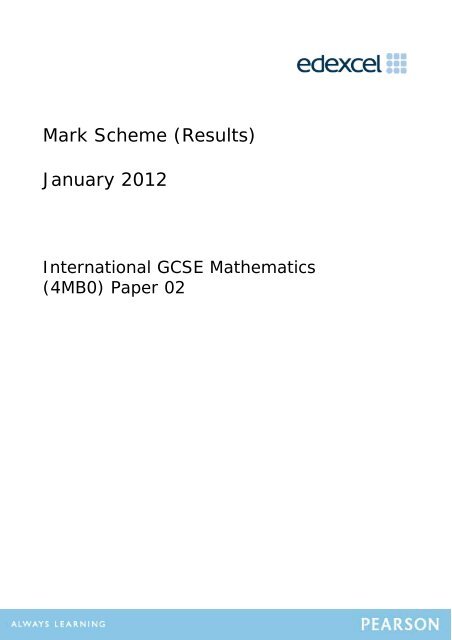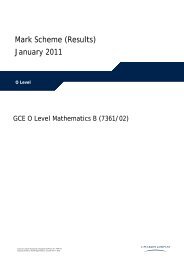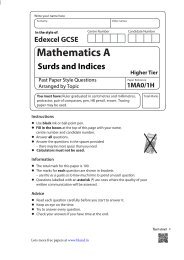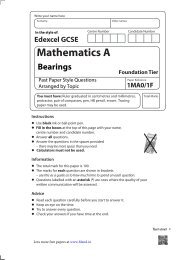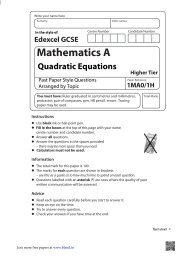Mark Scheme (Results) January 2012 - Bland
Mark Scheme (Results) January 2012 - Bland
Mark Scheme (Results) January 2012 - Bland
You also want an ePaper? Increase the reach of your titles
YUMPU automatically turns print PDFs into web optimized ePapers that Google loves.
<strong>Mark</strong> <strong>Scheme</strong> (<strong>Results</strong>)<br />
<strong>January</strong> <strong>2012</strong><br />
International GCSE Mathematics<br />
(4MB0) Paper 02
Edexcel and BTEC Qualifications<br />
Edexcel and BTEC qualifications come from Pearson, the world’s leading learning<br />
company. We provide a wide range of qualifications including academic,<br />
vocational, occupational and specific programmes for employers. For further<br />
information, please call our GCE line on 0844 576 0025, our GCSE team on 0844<br />
576 0027, or visit our qualifications website at www.edexcel.com. For information<br />
about our BTEC qualifications, please call 0844 576 0026, or visit our website at<br />
www.btec.co.uk.<br />
If you have any subject specific questions about this specification that require the<br />
help of a subject specialist, you may find our Ask The Expert email service<br />
helpful.<br />
Ask The Expert can be accessed online at the following link:<br />
http://www.edexcel.com/Aboutus/contact-us/<br />
Pearson: helping people progress, everywhere<br />
Our aim is to help everyone progress in their lives through education. We believe in<br />
every kind of learning, for all kinds of people, wherever they are in the world. We’ve<br />
been involved in education for over 150 years, and by working across 70 countries, in<br />
100 languages, we have built an international reputation for raising achievement<br />
through innovation in education. Find out more about how we can help you and your<br />
students at: www.pearson.com/uk<br />
<strong>January</strong> <strong>2012</strong><br />
Publications Code UG030756<br />
All the material in this publication is copyright<br />
© Pearson Education Ltd <strong>2012</strong>
General <strong>Mark</strong>ing Guidance<br />
• All candidates must receive the same treatment. Examiners must mark the first<br />
candidate in exactly the same way as they mark the last.<br />
• <strong>Mark</strong> schemes should be applied positively. Candidates must be rewarded for what<br />
they have shown they can do rather than penalised for omissions.<br />
• Examiners should mark according to the mark scheme not according to their<br />
perception of where the grade boundaries may lie.<br />
• There is no ceiling on achievement. All marks on the mark scheme should be used<br />
appropriately.<br />
• All the marks on the mark scheme are designed to be awarded. Examiners should<br />
always award full marks if deserved, i.e. if the answer matches the mark scheme.<br />
Examiners should also be prepared to award zero marks if the candidate’s<br />
response is not worthy of credit according to the mark scheme.<br />
• Where some judgement is required, mark schemes will provide the principles by<br />
which marks will be awarded and exemplification may be limited.<br />
• When examiners are in doubt regarding the application of the mark scheme to a<br />
candidate’s response, the team leader must be consulted.<br />
• Crossed out work should be marked UNLESS the candidate has replaced it with an<br />
alternative response.<br />
• Types of mark<br />
o M marks: method marks<br />
o A marks: accuracy marks<br />
o B marks: unconditional accuracy marks (independent of M marks)<br />
• Abbreviations<br />
o cao – correct answer only<br />
o ft – follow through<br />
o isw – ignore subsequent working<br />
o SC - special case<br />
o oe – or equivalent (and appropriate)<br />
o dep – dependent<br />
o indep – independent<br />
o eeoo – each error or omission<br />
• No working<br />
If no working is shown then correct answers normally score full marks<br />
If no working is shown then incorrect (even though nearly correct) answers score<br />
no marks.<br />
• With working<br />
If there is a wrong answer indicated on the answer line always check the working<br />
in the body of the script (and on any diagrams), and award any marks appropriate<br />
from the mark scheme.
If it is clear from the working that the “correct” answer has been obtained from<br />
incorrect working, award 0 marks.<br />
Any case of suspected misread loses A (and B) marks on that part, but can gain<br />
the M marks.<br />
If working is crossed out and still legible, then it should be given any appropriate<br />
marks, as long as it has not been replaced by alternative work.<br />
If there is a choice of methods shown, then no marks should be awarded, unless<br />
the answer on the answer line makes clear the method that has been used.<br />
If there is no answer on the answer line then check the working for an obvious<br />
answer.<br />
• Follow through marks<br />
Follow through marks which involve a single stage calculation can be awarded<br />
without working since you can check the answer yourself, but if ambiguous do not<br />
award.<br />
Follow through marks which involve more than one stage of calculation can only<br />
be awarded on sight of the relevant working, even if it appears obvious that there<br />
is only one way you could get the answer given.<br />
• Ignoring subsequent work<br />
It is appropriate to ignore subsequent work when the additional work does not<br />
change the answer in a way that is inappropriate for the question: eg. Incorrect<br />
cancelling of a fraction that would otherwise be correct.<br />
It is not appropriate to ignore subsequent work when the additional work<br />
essentially makes the answer incorrect eg algebra.<br />
Transcription errors occur when candidates present a correct answer in working,<br />
and write it incorrectly on the answer line; mark the correct answer.<br />
• Probability<br />
Probability answers must be given a fractions, percentages or decimals. If a<br />
candidate gives a decimal equivalent to a probability, this should be written to at<br />
least 2 decimal places (unless tenths).<br />
Incorrect notation should lose the accuracy marks, but be awarded any implied<br />
method marks.<br />
If a probability answer is given on the answer line using both incorrect and correct<br />
notation, award the marks.<br />
If a probability fraction is given then cancelled incorrectly, ignore the incorrectly<br />
cancelled answer.<br />
• Linear equations<br />
Full marks can be gained if the solution alone is given on the answer line, or<br />
otherwise unambiguously indicated in working (without contradiction elsewhere).<br />
Where the correct solution only is shown substituted, but not identified as the<br />
solution, the accuracy mark is lost but any method marks can be awarded.<br />
• Parts of questions<br />
Unless allowed by the mark scheme, the marks allocated to one part of the<br />
question CANNOT be awarded in another.
<strong>January</strong> <strong>2012</strong> International GCSE Mathematics (4MB0) Paper 02<br />
<strong>Mark</strong> <strong>Scheme</strong><br />
Question Working Answer <strong>Mark</strong> Notes<br />
Number<br />
1 6≤<br />
3x<br />
M1<br />
x ≥ 2<br />
A1<br />
3x−2x≤<br />
6<br />
M1<br />
NB: Condone use of “
Question Working<br />
Number<br />
4(a) ∑ f × x = 12.5× 20 + 30× 11+ 37.5× 27 + 50× 15 + 75× 15 + 95×<br />
12 (= 4607.5)<br />
(having at least two correct products in 6 summed products)<br />
"4607.5"<br />
100<br />
Answer: 46.1 <strong>Mark</strong>: 3<br />
Notes<br />
M1<br />
M1 (DEP)<br />
A1<br />
Question Working Answer <strong>Mark</strong> Notes<br />
Number<br />
4(b) Interval Frequency<br />
Density<br />
Given height and<br />
width drawn.<br />
0≤ t < 25 0.8<br />
25 ≤ t < 35 1.1<br />
35 ≤ t < 40 5.4<br />
40 ≤ t < 60 0.75 (given)<br />
60 ≤ t < 90 0.5<br />
90 ≤ t < 100 1.2<br />
4<br />
B4 (-1eeoo)<br />
Question Working Answer <strong>Mark</strong> Notes<br />
Number<br />
5(a) 1<br />
3 , 33.3%, 0.333 B1<br />
1<br />
Question Working Answer <strong>Mark</strong> Notes<br />
Number<br />
5(b) 1 1 1 1<br />
× + × (one correct pair of<br />
M1<br />
3 3 3 2<br />
probabilities)<br />
(adding 2 nd correct pair of<br />
probabilities)<br />
M1 (DEP)<br />
Conclusion with no wrong working<br />
seen<br />
3<br />
A1<br />
International GCSE Mathematics (4MB0) Paper 01 <strong>January</strong> <strong>2012</strong>
Question<br />
Number<br />
5(c)<br />
Working Answer <strong>Mark</strong> Notes<br />
Any one correct term from the<br />
following:<br />
M1<br />
1 1 1 1 1 1 1<br />
× , × , × ×<br />
3 3 3 2 3 3 2<br />
Three correct terms added together<br />
M1 (DEP)<br />
OR<br />
from<br />
1 – (one correct term)<br />
1<br />
" "<br />
3 , 5<br />
18 , 1 1 1<br />
× ×<br />
3 3 2<br />
1/3, 33.3%, 0.333<br />
A1<br />
M1<br />
1 – “(a)” – (b) -<br />
(all correct)<br />
1 1 1<br />
× ×<br />
3 3 2<br />
3<br />
M1 (DEP)<br />
Question<br />
Number<br />
6(a)<br />
Answer <strong>Mark</strong> Notes<br />
∆ ABC drawn and labelled 1 B1<br />
Question Working Answer <strong>Mark</strong> Notes<br />
Number<br />
6(b)(i) A 1 = (-1.5, 4.5)<br />
B 1 = (-6, 6),<br />
C 1 = (-9, 3) 2 B2 (-1 eeoo)<br />
Question Answer <strong>Mark</strong> Notes<br />
Number<br />
6(b)(ii) ∆ A 1 B 1 C 1 drawn and labelled 1 B1 ft<br />
Question Working Answer <strong>Mark</strong> Notes<br />
Number<br />
6(c)(i) A 2 =<br />
⎛3 1⎞<br />
⎜ , − 2 ⎟ or rounded ,<br />
⎝4 4⎠<br />
B 2 = (3, -3),<br />
C 2 = (4.5, -1.5) 2<br />
B2 ft (-1eeoo)<br />
Question Answer <strong>Mark</strong> Notes<br />
Number<br />
6(c)(ii) ∆ A 2 B 2 C 2 drawn and labelled 1 B1 ft<br />
International GCSE Mathematics (4MB0) Paper 01 <strong>January</strong> <strong>2012</strong>
Question<br />
Number<br />
6(d)<br />
Answer <strong>Mark</strong> Notes<br />
Reflection in the x-axis,<br />
Enlargement scale factor 0.8 (or better, 0.75),<br />
centre O<br />
OR<br />
Reflection in y-axis,<br />
Enlargement scale factor -0.8 (or better, -0.75),<br />
centre O<br />
NB: In ePEN, enter these marks in the order given above 3<br />
B1<br />
B1<br />
B1<br />
B1<br />
B1<br />
B1<br />
Question Working Answer <strong>Mark</strong> Notes<br />
Number<br />
7(a) 2 + 3 + 1 + x = 9<br />
x = 3 2<br />
M1<br />
A1<br />
Question Working Answer <strong>Mark</strong> Notes<br />
Number<br />
7(b) n(F) + 1 + “3” + 8 = 25<br />
n(F) = 13 2<br />
M1<br />
A1 ft<br />
Question Working Answer <strong>Mark</strong> Notes<br />
Number<br />
7(c) Uses n(( F ∩T)<br />
∩ C’) = 3<br />
“13” – (3+3+2)<br />
M1<br />
Football only = 5<br />
A1 ft<br />
⎡<br />
= n ( F∩C′ ∩ T′<br />
) = n( F∩( C∪T<br />
⎤<br />
)′<br />
⎢<br />
)<br />
⎣<br />
⎥⎦<br />
2<br />
Question<br />
Number<br />
7(d)(i)<br />
Working Answer <strong>Mark</strong> Notes<br />
Correctly shaded<br />
B1<br />
Question Answer <strong>Mark</strong> Notes<br />
Number<br />
7(d)(ii) F’ ∩( T ∪ C)<br />
represents those pupils who play cricket<br />
(tennis) ,<br />
and/or tennis (cricket).<br />
NB: allow just “and” 2<br />
B1 ft<br />
B1 ft<br />
Question Working Answer <strong>Mark</strong> Notes<br />
Number<br />
7(d)(iii) Football 1 B1<br />
1<br />
International GCSE Mathematics (4MB0) Paper 01 <strong>January</strong> <strong>2012</strong>
Question Working Answer <strong>Mark</strong> Notes<br />
Number<br />
8(a) 60 = 2h+ 2× 2π<br />
r (o.e.)<br />
M1<br />
cc 2 A1<br />
Question Working Answer <strong>Mark</strong> Notes<br />
Number<br />
8(b) 2<br />
V = π r h= πr 2 (30 −2 πr)<br />
M1<br />
(o.e.)<br />
A1<br />
cc 2<br />
Question Working <strong>Mark</strong> Notes<br />
Number<br />
8(c) dV<br />
2 2<br />
= 60π<br />
r− 6π<br />
r (one term correct)<br />
dr<br />
2 2<br />
60πr−<br />
6π<br />
r<br />
M1<br />
A1<br />
2 2<br />
60πr− 6π<br />
r = 0<br />
(o.e)<br />
∴6 πr(10 − π r ) = 0(factorising or cancelling r) (o.e)<br />
10<br />
r = and cc (eg r = 0 ⇒ V = 0 so unacceptable)<br />
π<br />
M1 (DEP on<br />
dV<br />
" " = 0)<br />
dr<br />
M1 (DEP)<br />
5<br />
A1<br />
Question<br />
Number<br />
9(a)(i)<br />
Question<br />
Number<br />
9(a)(ii)<br />
Question<br />
Number<br />
9(a)(iii)<br />
Working Answer <strong>Mark</strong> Notes<br />
<br />
OR = a 1<br />
B1<br />
Working Answer <strong>Mark</strong> Notes<br />
<br />
RB = b - “a” 1 B1 ft<br />
Working Answer <strong>Mark</strong> Notes<br />
<br />
AB = b – 4a 1 B1<br />
Question Working Answer <strong>Mark</strong> Notes<br />
Number<br />
9(b)(i) 2 B1 ft<br />
PB = "( b – 4a)”<br />
3<br />
(o.e) 1<br />
International GCSE Mathematics (4MB0) Paper 01 <strong>January</strong> <strong>2012</strong>
Question Working Answer <strong>Mark</strong> Notes<br />
Number<br />
9(b)(ii) 2<br />
M1<br />
OP = b-" ( b- 4 a)"<br />
3<br />
OR<br />
1<br />
OP = 4 a+ "( b- 4 a)"<br />
3<br />
8 1<br />
OP = a+<br />
b<br />
3 3<br />
2 A1<br />
Question<br />
Number<br />
9(c)(i)<br />
Working Answer <strong>Mark</strong> Notes<br />
<br />
MP = k”(b – a)” - “ PB ”<br />
coef of a in above = 0<br />
M1<br />
M1(DEP)<br />
k = 8 3 cc 3<br />
A1<br />
Question<br />
Number<br />
9(c)(ii)<br />
Question<br />
Number<br />
9(d)<br />
Working Answer <strong>Mark</strong> Notes<br />
<br />
MP = 2b 1 B1<br />
Working Answer <strong>Mark</strong> Notes<br />
<br />
OP =<br />
” a” + ma + l b<br />
1<br />
B1 ft (on (a(i))<br />
Question Working Answer <strong>Mark</strong> Notes<br />
Number<br />
9(e) 8 1<br />
M1<br />
" a+<br />
b " = “a + ma + l b”<br />
3 3<br />
Equate a coefs: 8 = 1+<br />
m<br />
3<br />
5<br />
m =<br />
3<br />
3<br />
M1 (DEP)<br />
A1<br />
International GCSE Mathematics (4MB0) Paper 01 <strong>January</strong> <strong>2012</strong>
Question<br />
Number<br />
Working<br />
Notes<br />
10(a) 2 2 2<br />
3 = 3 + 5 − 2× 3× 5× cos∠<br />
ABF<br />
2 2 2<br />
3 + 5 −3<br />
cos ∠ ABF =<br />
(o.e.)<br />
2× 3×<br />
5<br />
OR<br />
BY=2.5 cm (Y on AB st FY perpen to AB and ∵ ∆ABF is isosceles )<br />
2.5<br />
cos ∠ ABF =<br />
3<br />
Answer: 33.6 o<br />
<strong>Mark</strong>:3<br />
M1<br />
M1 (DEP)<br />
M1<br />
M1(DEP)<br />
A1<br />
Question<br />
Number<br />
10(b)<br />
Question<br />
Number<br />
10(c)<br />
Working <strong>Mark</strong> Notes<br />
BX = 1 cm<br />
(X is a pt on BC st FX is perpend to BC)<br />
1<br />
cos ∠ FBC =<br />
3<br />
Answer: 70.5 o 3<br />
Working Answer <strong>Mark</strong> Notes<br />
(Y is the mid-pt of AB)<br />
YZ = 1<br />
OR BX = 1<br />
(if using ∆FZX below)<br />
∆FZY: FY 2 = 3 2 – 2.5 2 (FY=1.658<br />
= 2.75 )<br />
FZ 2 = 2.75 - 1 2<br />
B1<br />
M1<br />
A1<br />
M1<br />
M1<br />
M1(DEP)<br />
OR<br />
∆FBZ: BZ 2 =2.5 2 + 1 2 (= 7.25)<br />
FZ 2 = 3 2 – “7.25”<br />
M1<br />
M1 (DEP)<br />
OR<br />
∆FZX: FX 2 = 3 2 – 1 2<br />
(FX 2 = 8= 2.828 )<br />
FZ 2 = “8” - 2.5 2<br />
1.32 , 1.33 cm<br />
4<br />
M1<br />
M1 (DEP)<br />
A1<br />
International GCSE Mathematics (4MB0) Paper 01 <strong>January</strong> <strong>2012</strong>
Question Working <strong>Mark</strong> Notes<br />
Number<br />
10(d) 1 M1 ( area)<br />
∆ AFB =∆ CDE = × 5 × 3 × sin"33.6" ( = 4.15)<br />
2<br />
1<br />
OR 5 "1.658"<br />
2 × ×<br />
ABCD = 10x5<br />
M1 (Rect. area)<br />
2 2<br />
FX = 3 − 1 ( = 2.828)<br />
OR 3 × sin70.5°<br />
AFED=BCEF= 1 "2.828" (8 10) ( 25.45)<br />
2 × × + =<br />
M1 (Trap. area)<br />
Total SA = ”50” + 2 x”4.15” + 2 x”25.45”<br />
(adding FOUR correct areas)<br />
Adding ALL correct areas<br />
Answer: 109 cm 2<br />
6<br />
M1 (DEP on all<br />
Ms above)<br />
M1 (DEP)<br />
A1<br />
Question Working Answer <strong>Mark</strong> Notes<br />
Number<br />
11(a) 2.12<br />
1.85<br />
2.59 3<br />
B1<br />
B1<br />
B1<br />
Question<br />
Number<br />
11(b)<br />
Answer<br />
Curve<br />
-1 mark for straight line segments<br />
⎛ 1 ⎞<br />
each point missed ⎜±<br />
small square ⎟<br />
⎝ 2<br />
⎠<br />
each missed segment<br />
each point not plotted<br />
⎛ 1 ⎞<br />
each point incorrectly plotted ⎜±<br />
small square ⎟<br />
⎝ 2<br />
⎠<br />
tramlines<br />
very poor curve 3<br />
<strong>Mark</strong> Notes<br />
B3 (-1eeoo)<br />
Question Answer <strong>Mark</strong> Notes<br />
Number<br />
11(c) Drawn line going through (1, 2.2) and (4, 2.8) 1 B1<br />
International GCSE Mathematics (4MB0) Paper 01 <strong>January</strong> <strong>2012</strong>
Question<br />
Number<br />
11(d)<br />
Working Answer <strong>Mark</strong> Notes<br />
(Identifying pts of intersection of<br />
“line” and “curve”)<br />
1.4 ft and 3.6 ft<br />
B1 ft<br />
NB: (1) awrt to 1.4 ft and 3.6 ft<br />
(2) Condone “
Further copies of this publication are available from<br />
Edexcel Publications, Adamsway, Mansfield, Notts, NG18 4FN<br />
Telephone 01623 467467<br />
Fax 01623 450481<br />
Email publication.orders@edexcel.com<br />
Order Code UG030756 <strong>January</strong> <strong>2012</strong><br />
For more information on Edexcel qualifications, please visit<br />
www.edexcel.com/quals<br />
Pearson Education Limited. Registered company number 872828<br />
with its registered office at Edinburgh Gate, Harlow, Essex CM20 2JE


